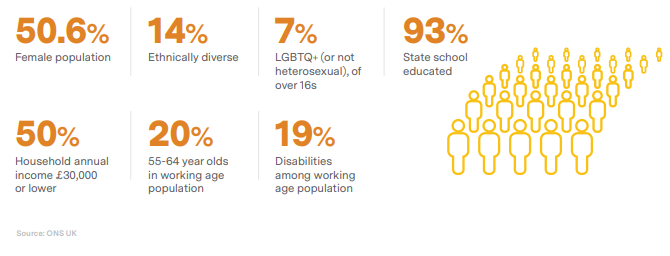Single-issue interest groups have huge advantages. They bring focus and message discipline, as well as build deep and genuine commitment to the causes they champion. Some of the great progressive steps in society over the last century have been taken by those championing specific ideas (e.g., women’s right to vote, the decriminalization of homosexuality, equal civil rights for the Black community in the United States).
Ethnic diversity championing can be seen through the same lens, and all efforts toward the end goal for greater equity and inclusion need to be lauded. At the same time, it is beneficial to view the ethnic diversity agenda as part of, rather than separate from, the wider D&I efforts in companies. Given our earlier comment about how politically and emotionally loaded race-related topics can become, it is well worth reflecting on some of the collateral damage that well-intentioned initiatives can cause.
Numbers matter in any D&I discussion, but only to a point (e.g., 50.6 percent of the UK population is female, 14+ percent is ethnically diverse, and 7 percent categorizes itself as not being heterosexual, according to the Office of National Statistics, UK). These are very material numbers, and provide excellent grounds for material investment in positive action on the gender, ethnicity, and LGBTQ+ agendas.
At the same time, there are other numbers, easily available and often in plain sight, that receive nowhere close to the same level of empathy. For example, 93 percent of students in the UK are educated in the state school system, while anecdotally it is clear that a high proportion of senior leadership is either privately educated in the UK, or imported global talent educated abroad. Similarly, the median disposable household income in the UK is £30,000, and very little attempt has been made by companies to capture the socio-economic backgrounds and make-up of their workforce and leadership. Socio-economic disparities coupled with regional divides are already playing out in our politics and will inevitably flow through into boardroom discussions sooner rather than later.
It is important that all companies get ahead of the curve on incorporating socioeconomic considerations into their talent policies, before social pressures force their hand – it is the right thing to do. Incorporating a socio-economic lens allows companies to tackle the problem of socio-economic disadvantage within large sections of the majority White population. Our hope is that in parallel to sufficient progress on the ethnicity agenda, a good emphasis of inclusion practices is also invested in socio-economic considerations.
Education
Percentage of 18-year-olds enrolled in higher education, as of 2018, in the UK

Approximate UK population statistics
(as per ONS, UK)

As getting a degree is an important factor in future economic prospects, the country has a massive problem looming in large segments of the White population.
Two other looming problems that do not receive sufficient attention are discrimination on the basis of age and disabilities. According to Office of National Statistics, UK, around 20 percent of the UK working age population is between the ages of 55 and 64. This number will only grow as society ages and will be further amplified as people have to work later in their lives as life expectancy increases and savings and pension pots turn out to be insufficient for a vast majority of people. Far from being progressive and inclusive on the topic of age discrimination, we feel that in most UK companies, there are explicit and implicit biases at work against older people that restrict their economic prospects. Typically starting in one’s early 50s, these discriminatory tendencies sharpen and become very prominent once people cross the age of 55. Each individual decision may feel acceptable (e.g., “He couldn’t possibly be a CEO candidate, as he just turned 58 and wouldn’t have enough runway,” may feel like an innocent comment around the board table, but is very likely to be discriminatory unless you have medical advice to back this up.) Similarly, on the shop and factory floors, the preference for younger, “more energetic” workforces can cause similar situations and the same applies to many middle management situations.
When it comes to disabilities, the Office of National Statistics, UK, reports that 19 percent of the UK working age population suffers from some form of disability that may restrict their job opportunities, create challenges to job progression and promotion, and in a vast majority of cases may be corrected by positive interventions and support by companies. As with age discrimination, disabilities receive nowhere near the amount of attention they deserve.
In summary, the power and impact of single-issue focus can be extraordinary. However, the best companies need to balance this with a multi-issue lens, including tackling not just topics of today, or those in the news, but also the topics of tomorrow, and those that are deserving of attention.




